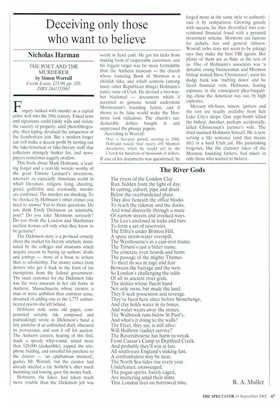Deceiving only those who want to believe
Nicholas Harman
THE POET AND THE MURDERER by Simon Worrall Fourth Estate, 115.99, pp. 320, ISBN 1841155861 Forgery ranked with murder as a capital crime well into the 19th century. Faked texts and signatures could falsify wills and violate the sanctity of property, until photolithography, then typing, devalued the uniqueness of the handwritten text. But a modern forger can still make a decent profit by turning out the fake-historical or fake-literary stuff that collectors strangely hanker for, and newspapers sometimes eagerly swallow.
This book about Mark Hofmann. a leading forger and a real-life weirdo worthy of the great Elmore Leonard's inventions, uncovers an especially American world in which literature, religion, lying, cheating, greed, gullibility and, eventually, murder are combined. The murders are shocking. To be shocked by Hofmann's other crimes you need to answer Yes to three questions: Do you think Emily Dickinson an inimitable poet? Do you take Mormons seriously? Do you think the London and Manhattan auction houses sell only what they know to be genuine?
The Dickinson story is a po-faced comedy about the market for literary artefacts, dominated by the colleges and museums which acquire esteem by buying up authors' drafts and jottings — more of a boon to writers than to scholarship. The money conies from donors who get it back in the form of tax exemptions from the federal government. The main customer for the Dickinson fake was the twee museum in her old home in Amherst, Massachusetts, whose curator, a man of more ambition than common sense, dreamed of adding one to the 1,775 authenticated poems she left behind.
Hofmann stole some old paper, compounded suitable ink, composed and painstakingly wrote in Dickinson's hand a tiny pastiche of an unfinished draft, obscured its provenance, and sent it off for auction. The Amherst curator, hearing of this find, made a speedy whip-round, raised more than S20,000 (deductible), topped the telephone bidding, and unveiled his purchase to the donors — an epiphanous moment', gushes Mr Worrall, but the curator had already smelled a rat. Sotheby's, after much humming and hawing, gave the money back.
Hofmann. the faker, had taken much more trouble than the Dickinson job was worth in hard cash. He got his kicks from making fools of respectable customers, and his biggest target was far more formidable than the Amherst museum — the church whose founding Book of Mormon is a childish fake, and which controls (among many other Republican things) Hofmann's native state of Utah. He devised a two-waybet blackmail — documents which if accepted as genuine would undermine Mormonism's founding fiction, and if shown to be false would make the Mormons look ridiculous. The church's taxdeductible dollars bought in and suppressed the phoney papers.
According to Worrall:
Over a five-year period. starting in 1980, Hofmann would 'find' nearly 450 Mormon documents, which he would sell to the Church for hundreds of thousands of dollars.
If one of his documents was questioned, he forged more in the same style to authenticate it by comparison. Growing greedy with success, he then diversified into conventional financial fraud with a pyramid investment scheme. Mormons are famous for jackets, ties and general tidiness. Worrall (who does not seem to be joking) says they make the best FBI agents. But plenty of them are as flaky as the rest of us. One of Hofmann's associates was 'a dynamic young businessman and Mormon bishop named Steve Christensen'; soon his dodgy bank was 'melting down' and he faced financial ruin. Hofmann, fearing exposure in the consequent plea-bargaining, chose the American way out, by high explosive.
Mercury tilt-fuses, timers, igniters and the rest are readily available from Salt Lake City's shops. One pipe-bomb killed the bishop. Another, perhaps accidentally, killed Christensen's partner's wife. The third maimed Hofmann himself. He is now serving a life sentence (and that means Life) in a hard Utah jail. His painstaking forgeries, like the clumsier fakes of the Mormon founding fathers, had taken in only those who wanted to believe.










































































 Previous page
Previous page